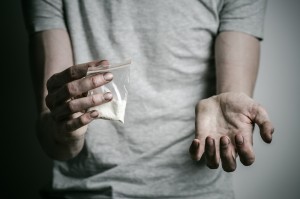by Meg Fluharty @MegEliz_
This blog originally appeared on the Mental Elf site on 15th October 2015.
Many individuals in the criminal justice system have both mental health and substance use problems. There is little evidence targeting the treatment programmes for offenders, alongside the additional challenges faced by those with co-occurring mental illnesses.
The Cochrane Drugs and Alcohol Group have published a set of four reviews centred on interventions for drug-using offenders. This is an updated review, targeting offenders with co-occurring mental illnesses, which was originally published in 2006. We blogged about the review when it was last updated in March 2014, but this new version has more evidence (3 new RCTs) included.

Methods
The review authors searched the usual comprehensive list of databases to identify randomised controlled trials (RCTs) to identify whether treatments for drug using offenders with co-occurring mental illnesses:
- Reduced drug use
- Reduced criminal activity
- Whether the treatment setting affected the intervention
- Whether the type of treatment affected the outcome
All participants, regardless of gender, age or ethnicity, were included in this analysis.
The updated search (from March 2013 – April 2014) added 3 new trials to the review, totalling 14 publications representing 8 trials published between 1999 and 2014.
Study characteristics
- 6 studies were conducted in secure settings and 2 studies were conducted in a court setting
- No studies assessed pharmacological treatments or were conducted in the community
- All studies were conducted in the United States
- Study duration varied from 3 months to 5 year follow-up
- 7 studies investigated adult offenders, while one study investigated adolescent offenders (aged 14 -19)
- 3 studies included female offenders, while adult male offenders filled the majority of the population in the remaining studies.
Results
Therapeutic community and aftercare versus treatment as usual
Impact on drug use (self-report)
- Two studies reported a reduction in drug use:
- (Sacks, 2004) (RR 0.58 95% CI 0.36 to 0.93, 139 participants)
- (Sacks, 2008) (RR 0.73, 95% CI 0.53 to 1.01, 370 participants)
- One study reported no reduction:
- (Wexler, 1999) (RR 1.11 95% CI 0.82 to 1.49, 576 participants)
Impact on criminal activity
- Two studies reported no reduction in re-arrests following treatment:
- (Sacks, 2008) (RR 1.65, 95% CI 0.83 to 3.28, 370 participants)
- (Wexler, 1999) (RR 0.96, 95% CI 0.82 to 1.13, 428 participants)
- Three studies evaluated the impact of therapeutic community treatment using re-incarceration measures
- Two studies reported reductions:
- (Sacks, 2004) (RR 0.28, 95% CI 0.13 to 0.63, 193 participants)
- (Sacks 2011) (RR 0.49, 95% CI 0.27 to 0.89, 127 participants)
- One study found no effects:
- (Sacks, 2008) (RR 0.73, 95% CI 0.45 to 1.19, 370 participants)
- Two studies reported reductions:
Mental health court and case management versus treatment as usual (standard court proceedings)
Impact on drug use (self-report)
- No data available
Impact on criminal activity
- One study reported no reduction in criminal activity:
- (Cosden, 2003) (RR 1.05, 95% CI 0.90 to 1.22, 235 participants)
Motivational interviewing and cognitive skills versus relaxation therapy
Impact on drug use (self-report)
- Two studies reported no reduction in drug use:
- (Stein 2011) (MD -7.42, 95% CI -20.12 to 5.28, 162 participants)
- (Lanza 2013) (RR 0.92, 95% CI 0.36 to 2.33, 41 participants)
Impact on criminal activity
- No data available
Interpersonal psychotherapy versus a psychotherapy versus a psycho-educational intervention
Impact on drug use (self-report)
- One study reported no reduction in drug use:
- (Johnson 2012) (RR 0.67, 95% CI 0.30 to 1.50, 38 participants)
Impact on criminal activity
- No data available

Discussion
This updated review included eight studies conducted within secure settings and in the judicial system. There were no studies for drug abusing offenders with mental illnesses under parole identified for inclusion within this review. Therefore, it’s difficult to compare if interventions are more beneficial within the community or under probation services.
Additionally, as all studies were conducted in the United States, it’s possible the treatments may not be generalisable outside the American judicial system, and as drug-use was self-report rather than biological measures, some caution needs to be taken when interpreting the results.
Generally, there was large variation across the studies, making comparisons difficult. However, two of the five trials displayed some evidence for therapeutic aftercare in relation to reducing subsequent re-incarceration.

Links
Primary paper
Perry AE, Neilson M, Martyn-St James M, Glanville JM, Woodhouse R, Godfrey C, Hewitt C. Interventions for drug-using offenders with co-occurring mental illness. Cochrane Database of Systematic Reviews 2015, Issue 6. Art. No.: CD010901. DOI: 10.1002/14651858.CD010901.pub2.
Other references
Sacks S, Sacks JY, McKendrick K, Banks S, Stommel J. Modified TC for MICA inmates in correctional settings: crime outcomes. Behavioural Sciences and the Law 2004;22(4):477-501. [PubMed abstract]
Sullivan CJ, McKendrick K, Sacks S, Banks S. Modified therapeutic community treatment for offenders with MICA disorders: substance use outcomes. American Journal of Drug and Alcohol Abuse 2007; Vol. 33, issue 6:823-32. [0095-2990: (Print)] [PubMed abstract]
Sacks JY, McKendrick K, & Hamilton ZK. A randomized clinical trial of a therapeutic community treatment for female inmates: outcomes at 6 and 12 months after prison release. Journal of Addictive Diseases 2012;31(3):258-69. [PubMed abstract]
Sacks JY, Sacks S, McKendrick K, Banks S, Schoeneberger M, Hamilton Z, et al. Prison therapeutic community treatment for female offenders: Profiles and preliminary findings for mental health and other variables (crime, substance use and HIV risk). Journal of Offender Rehabilitation 2008;46(3-4):233-61. [: 1050-9674] [Abstract]
Prendergast ML, Hall EA, Wexler HK. Multiple measures of outcome in assessing a prison-based drug treatment program. Journal of Offender Rehabilitation 2003;37:65-94. [Abstract]
Prendergast ML, Hall EA, Wexler HK, Melnick G, Cao Y. Amity prison-based therapeutic community: 5-year outcomes. Prison Journal 2004;84(1):36-50. [Abstract]
Wexler HK, DeLeon G, Thomas G, Kressel D, Peters J. The Amity prison TC evaluation – re incarceration outcomes. Criminal Justice and Behavior 1999a;26(2):147-67. [Abstract]
Wexler HK, Melnick G, Lowe L, Peters J. Three-year re incarceration outcomes for Amity in-prison therapeutic community and aftercare in California. The Prison Journal1999b;79(3):321-36. [Abstract]
Cosden M, Ellens JK, Schnell JL, Yamini-Diouf Y, Wolfe MM. Evaluation of a mental health treatment court with assertive community treatment. Behavioral Sciences and the Law2003;21(4):415-27. [Abstract]
Stein LA, Lebeau R, Colby SM, Barnett NP, Golembeske C, Monti PM. Motivational interviewing for incarcerated adolescents: effects of depressive symptoms on reducing alcohol and marijuana use after release. Journal of Studies on Alcohol and Drugs2011;72(3):497-506. [PubMed abstract]
Lanza PV, Garcia PF, Lamelas FR, Gonzalez-Menendez A. Acceptance and commitment therapy versus cognitive behavioral therapy in the treatment of substance use disorder with incarcerated women. Journal of Clinical Psychology 2014;70(7):644-57. [DOI:10.1002/jcip.22060]
Johnson JE, Zlotnick C. Pilot study of treatment for major depression among women prisoners with substance use disorder. Journal of Psychiatric Research 2012;46(9):1174-83. [DOI: 10.1016/j.jpsychires.2012.05.007]
– See more at: http://www.nationalelfservice.net/mental-health/substance-misuse/drug-using-offenders-with-co-occurring-mental-illness/#sthash.CnpCuCWr.dpuf

